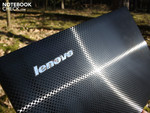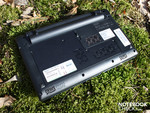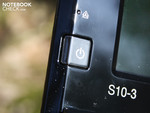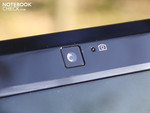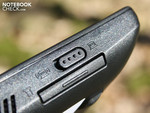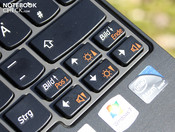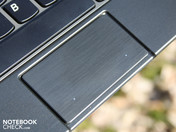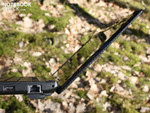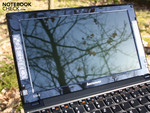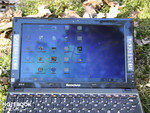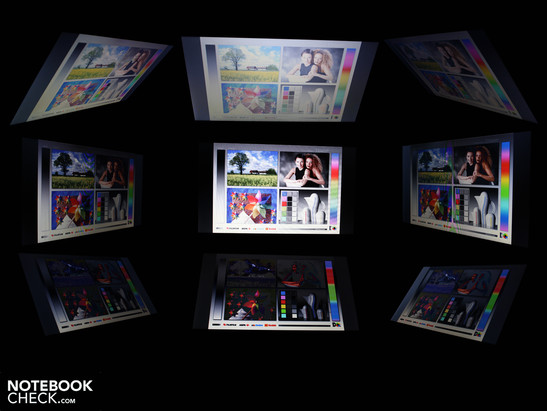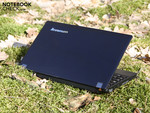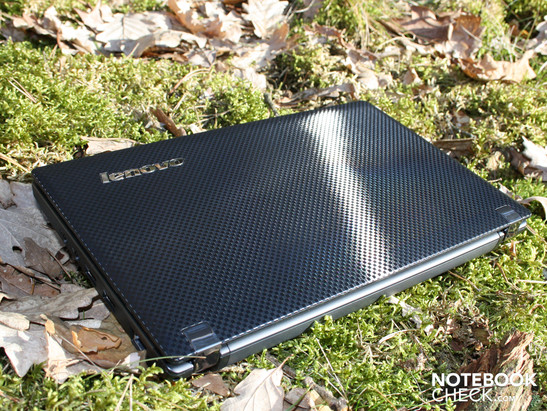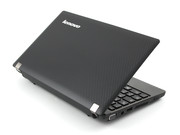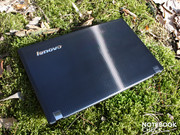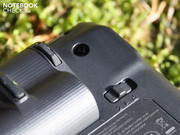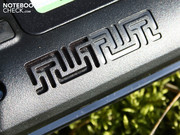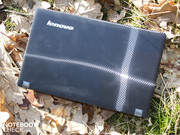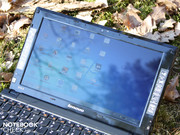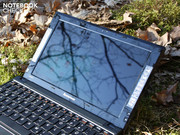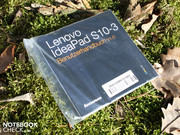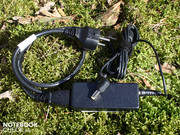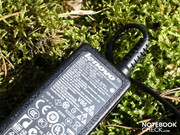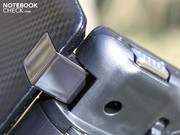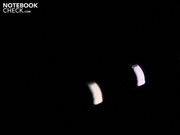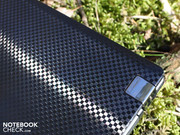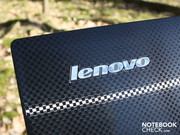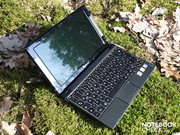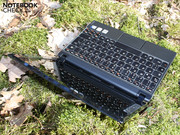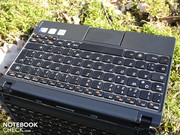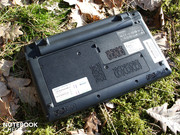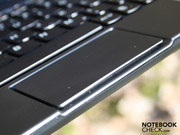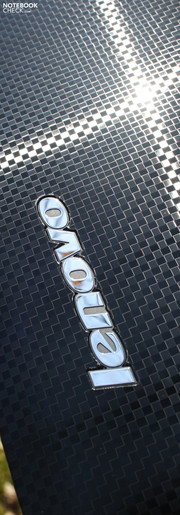Review Lenovo IdeaPad S10-3 Netbook
Stylish Appearance
Is every netbook like the other? Lenovo's product designers have racked their brains. How is our Pine Trail netbook different from those of the competitors? How can we vindicate a higher price despite the same hardware? Once again, the answer to this has been left up to the looks and workmanship. Read in this comprehensive review if the strategy has been a success.
One netbook is soon followed by others. In the last few months, where one manufacturer after the other launched their netbooks with the newest Pine Trail platform onto the market, Lenovo belongs to those who have taken quite a bit of time. The first Asus Pine Trail was already in notebookcheck's office in the last days of December. Now we can guess why it took so long: The manufacturer has worked on the looks until the final product was styled just right. The IdeaPad S10-3 - the trendy netbook? Is the 10 incher able to do more than just look good? We'll put it to an intensive netbook check.
Case
Lenovo has come up with an astonishingly high-end case for its Pine Trail netbook. Lid, work surface and base plate have a qualitative material feel that is due to coated aluminum surfaces, finely structured plastic and exact gaps. The solid aluminum lid, into which a pattern with the finest grooves has been worked, is especially an eye-catcher. The lid is pleasant to hold, is stable and fingerprints aren't left behind. Lenovo has managed to build a good looking case that can do without a high-gloss lid. The only glossy surfaces are the display's bezel and the glare type screen.
The wrist-rest surface, the area above the keys and the base plate have a tight fit and don't bend anywhere even under stronger pressure. The lid is very stiff in consideration of its flat design. We can only bend these by a few degrees when we pick it up at the corners. Light pressure on the lid surface doesn't force it to dent. Both display hinges are fixed tight. Thus, the display stays firmly in place in every position. The lid doesn't teeter under jolts (train or car journeys). Merely the end position coils slightly when opened to the maximum.
Connectivity
Lenovo doesn't place any connections, buttons or cardreaders on the thin front part. We've found all ports on the right or left. The rear is completely reserved for the battery. The port distribution seems logical: The VGA is directly beside the DC-in on the left. Thus, no thick cables impede the use of a righty mouse. Those who navigate on the left have the advantage that VGA, USB and power cable are in the back part.
The cardreader and audio sockets are on the left and right front area. This way, protruding cables or a thick USB stick can only obstruct to a certain extent. Connections on the rear would have of course been perfect for the use on the desk at home. But then, it wouldn't have been possible to build in a battery that can be removed from the back.
Input Devices
Keyboard
The keyboard is suitable for frequent typists. That is if they can ignore the obviously bending key bed. Our hands accepted the whole width used for the keyboard very well. The detached keys have sufficiently sized gaps for big hands, which increases the accuracy. The pressure point is very distinct but the stroke is too smooth for our taste. This is because the key surface isn't fixed tight in the center area.
But it could be worse. The well-made layout with the big keys and the clear lettering has to be emphasized positively in comparison to the competitors. The red function key for calling up special functions, like display brightness, volume, mute, play/stop or WLAN activity are very visible.
Touchpad
The touchpad is on the wrist-rest's level. Lenovo has separated it evidently from the wrist-rest by a gap. The reason for this is the omission of extra mouse keys. They are underneath the pad (right + left) and are triggered by a click on the front surface. This actually works quite well. The surface is responsive up to the edges, but only up to the lower marking (two bright points).
It is a multi-touch pad (Synaptics Touchpad V7.4) and recognizes the use of two fingers, making two finger gestures possible. However, gesture recognition (e.g. zooming with two fingers) is disabled in the state-of-delivery. This has to be first enabled in mouse properties if required. It's of course possible to make fine adjustments there, as well.
Display
The reflective AUO screen (type AUO B101AW02 V0) has a native resolution of 1024x600 pixels in 10 inches (WSVGA). That is netbook standard. The glare type display's extremely poor contrast is equally standard. We've determined 173:1 at 114cd/m2 (center). A higher contrast would have been desirable but generally can't be expected in this price category. Colors look rather more faint and pallid than crisp and fresh. The glare display, however, deceives the eye and gives the colors a certain amount of brilliance back.
An external monitor or TV can be connected (with an adapter) via the analog video-out (VGA). An HDMI-out would be advantageous for higher resolutions. However, it's rare in classic netbooks.
| |||||||||||||||||||||||||
Brightness Distribution: 88 %
Center on Battery: 218 cd/m²
Contrast: 173:1 (Black: 1.32 cd/m²)
The screen's brightness doesn't have to hide with the achieved 228 cd/m2. The average on the entire surface is ultimately 214.4 cd/m2, even if the luminosity drops to 201 cd/m2 in some areas. Battery mode doesn't dim the brightness, unless the user sets the according in the energy savings options.
The long battery life and outdoor suitable manufacturing are just inviting for a stay in the sun. If you want to check your emails while drinking a coffee, you'll soon be annoyed quickly by reflections. The brightness may be good, but it's not strong enough to work against that effectively. A luminosity beyond 250 cd/m2 would have been beneficial in view of the reflections on the screen. This way, a pleasant use in sunlight is hardly possible.
The horizontal viewing angles are fairly good. We can see writing quite well up to a deviation of 45 degrees from the optimal position. First then do the colors invert. The image dims already at about 25 degrees, though. When we look downwards, it doesn't look as good (vertical). Writing is only well readable up to about 40 degrees. The brightness, however, already dims considerably as of 10 degrees. If several pairs of eyes are gathered before the IdeaPad S10-3, the viewers can barely recognize anything from upper positions. The colors are already intensely inverted at a 40 degree deviation upwards. Writing can't be recognized any longer and the colors are falsified.
Performance
The netbook, IdeaPad S10-3, is based on Intel's Atom N450 processor (1.66 GHz) with an integrated GMA 3150 graphic without a dedicated memory. The processor has a small L2 cache of 512 KB. The FSB is 667 MHz. The performance specs have only been improved insignificantly in comparison to the Atom predecessors N270/N280. Intel's hyperthreading technology makes a second virtual core available for applications. Therefore, the single-core processor can work fairly well with a multi-tasking OS, like Windows 7 or XP, despite the weak computing performance. The processor is supported by a 1024 MB RAM (one DDR2 SDRAM bar) and a 250 GB hard disk from Western Digital.
The graphic performance is, as already in netbooks of the first generation with GMA 950, non-existent. The DirectX 9 GPU, GMA3150, contributes just as little as its predecessors. 3DMark2006, for instance, finishes with 139 points. In comparison: Current mainstream notebooks with a midrange graphic card achieve 5000 to 6000 points in 3DMark2006. There is also no HD support from the GPU. The result: The S10-3 can't render 720p and 1080p coded videos smoothly. Broadcom HD decoders are currently the preferred choice to remedy this shortcoming. See Dell's Inspiron Mini 1012 with a Broadcom Crystal HD.
Our synthetic processor benchmarks certify the Intel Atom N450 processor with 1.66 GHz a typically poor netbook performance. A little comparison: The multi-core test, Cinebench R10, reaches a proud 5444 points with the current midrange Intel Core i3-330M processor (two cores, no turbo boost, hyperthreading). The N450 built into the S10-3 has to be satisfied with 868. This difference isn't new for the computing performance in comparison to a notebook. Nevertheless, it affects the experienced application speed negatively.
The performance of Windows 7 Starter isn't particularly good. Directories, files or new programs only opened with an evident delay even in high performance mode. We experienced almost infinite delays as soon as programs ran simultaneously or programs with a fairly large hard disk access or CPU load were active in the background. Playing music, having a browser with five tabs open and writing emails in Thunderbird at the same time? This scenario results in long waiting times and really kills the fun with the S10-3. If the user can accommodate to the low performance is something every buyer will have to decide for himself. Mobile surfing and checking emails - that can be done adequately fast. The IdeaPad S10-3 isn't a notebook replacement, though. But this applies just as much for all other representatives of the netbook class.
| 3DMark 2001SE Standard | 2717 points | |
| 3DMark 05 Standard | 301 points | |
| 3DMark 06 1280x800 Score | 492 points | |
Help | ||
The Western Digital hard disk (type WD2500BEVT-24A23T0, 5.400 rpm) with a gross capacity of 250GB only achieves an under average data throughput rate in HDTune. 49 MB/s in the sequential read test aren't cutting edge for 2.5 inch notebook hard disks. The slow HDD velocity beside the weak processor is the reason for the netbook's poor application speed. The HDD isn't audible even under heavy reading and writing head activity. We have to place an ear on it in order to even hear a noise.
Emissions
System Noise
The S10-3's poor performance data have two advantages - a long battery life and a low waste heat. Thus, the system noise characterizes the netbook's image pleasantly. The fan that really exists remains disabled and consequentially, the 10.1 incher remains inaudible in normal use with a consistent 29.9 dB(A). If you only surf a bit and read photos from a memory card every now and again, you'll never notice the fan's existence.
If the processor is constantly put under high load, the little fan only becomes audible with just only 30.1 dB(A). That is wickedly quiet. Our ergonomic impression is, thus, undimmed. We are barely ever confronted with such a quiet mini, even in the netbook world.
Noise Level
| Idle |
| 29.9 / 29.9 / 29.9 dB(A) |
| HDD |
| 29.9 dB(A) |
| Load |
| 29.9 / 30.1 dB(A) |
 | ||
30 dB silent 40 dB(A) audible 50 dB(A) loud |
||
min: | ||
Temperature
The waste heat also stays on the ground. The highest temperature that we can measure on the case is 38.1 degrees Celsius. We had to put the netbook to 100 percent processor capacity for this (Prime95). The average temperature of the wrist-rest is merely 30 degrees Celsius during this stress test. The temperature of the Atom processor reaches 60 degrees Celsius at most in the stress test. So, the fan isn't only quiet but also doesn't miss its effect on the components, either.
If you surf, check emails or watch video clips with the IdeaPad S10-3, you can take delight in pleasant temperatures between 28 and 30 degrees. The base plate is a bit warmer with 31. to 35 degrees, but it's on a good level for an almost silent netbook.
(+) The maximum temperature on the upper side is 33.1 °C / 92 F, compared to the average of 33.1 °C / 92 F, ranging from 21.6 to 53.2 °C for the class Netbook.
(+) The bottom heats up to a maximum of 38.1 °C / 101 F, compared to the average of 36.6 °C / 98 F
(+) In idle usage, the average temperature for the upper side is 28.8 °C / 84 F, compared to the device average of 29.8 °C / 86 F.
(+) The palmrests and touchpad are reaching skin temperature as a maximum (33.1 °C / 91.6 F) and are therefore not hot.
(-) The average temperature of the palmrest area of similar devices was 29.3 °C / 84.7 F (-3.8 °C / -6.9 F).
Loudspeakers
The sound system, consisting of two loudspeakers below the wrist-rest, isn't very impressive as in most netbooks, due to the small space available. There aren't any basses, the sound is thin and the trebles are excessively emphasized. The volume, in comparison, is appealingly high for a 10 incher.
Connecting loudspeakers via a 3.5 jack cable helps a lot. The level tethered to the notebook can be regulated upwards as desired. The Dolby sound function especially makes sense when using headphones. The intensity of basses and thus the music's spacial density can be increased with it. Sound purists might sense the sound as too bass heavy in this case, though.
Battery Life
We find the battery runtime very good. The following specs about the runtime are remarkable, especially in view of the battery pack's low capacity of 4100 mAh (48 Wh). The maximum battery life with BatteryEater in Reader mode is recorded with 556 minutes (9:16 hours). However, this runtime is unrealistic because WLAN is disabled and the brightness is set to the lowest level, and the processor is idle.
The real battery life is very close to our WLAN surfing test. The battery is drained after 7:47 hours (407 minutes). We visited news sites and downloaded a few files in this time. The LED screen ran in medium setting, so a bit over 140 cd/m2, during this test. The minimum runtime in the highest possible power consumption is still almost four hours (227 minutes).
A DVD runtime is a standard for our tests. However, because this is difficult without a DVD drive, we've connected a USB DVD drive with an own power supply for the test run. The movie fun was over after almost seven hours (408 minutes). The runtime would be shorter with a USB DVD drive that would be supplied with power over USB.
The IdeaPad S10-3 belongs to the devices with the lowest power requirement in the already economic netbook family. The effective power is reduced to 4.8 watts with maximum energy savings options (brightness, wireless modules, idle). Merely Acer's Aspire One 532 (4.5 watts) or Asus' Eee PC 1005PE (4.6 watts) were even more saving. But it doesn't get very high even with the highest brightness and enabled wireless modules, either. We can determine 7.3 watts as the maximum idle power consumption. Only a hand full of netbooks is even more economic here
The low standby consumption also seems to be very praiseworthy. Our multimeter only measures 0.1 watts (standby or off). If you put the S10-3 under demand and let the graphics and CPU work, you can increase the power requirement up to 13.7 watts. The battery wasn't inserted during our assessments about power consumption.
| Off / Standby | |
| Idle | |
| Load |
|
Verdict
The IdeaPad S10-3 is so new that the manufacturer didn't even have the time to put it on their German product homepage. The S10-3 M33D6GE black is already listed in online shops, though. The price of 329 euro shows that Lenovo doesn't regard the price war as the ultima ratio. The Pine Trail 10 incher from Asus, Acer, Packard Bell or MSI cost between 249 and 299 euro. What does Lenovo bid for the higher price?
It's especially the high-end feel, the solid construction and the lid's pretty looks that are scaled up. A good looking lid free of greasy fingerprints has a "higher value" than a colossal 9 hour runtime. The S10-3 has to accept criticism for its reflective display and yielding keyboard. A really mobile mini notebook simply shouldn't show up with annoying reflections.
If you are looking for a well built netbook with a long battery life, you should consider the Ideapad S10-3 despite its higher price. It's not the ultimately perfect netbook, as the N220 has already earned itself this title. Samsung's mini doesn't have any weakness in the keyboard and also comes with a bright, AR-coated TFT. The smallest "problem" is the high-gloss lid.
A possible alternative from Lenovo would also be the Thinkpad X100e, with a matt display and a bit more power. However, it's also a lot more expensive with about 500 euro.


 Deutsch
Deutsch English
English Español
Español Français
Français Italiano
Italiano Nederlands
Nederlands Polski
Polski Português
Português Русский
Русский Türkçe
Türkçe Svenska
Svenska Chinese
Chinese Magyar
Magyar
